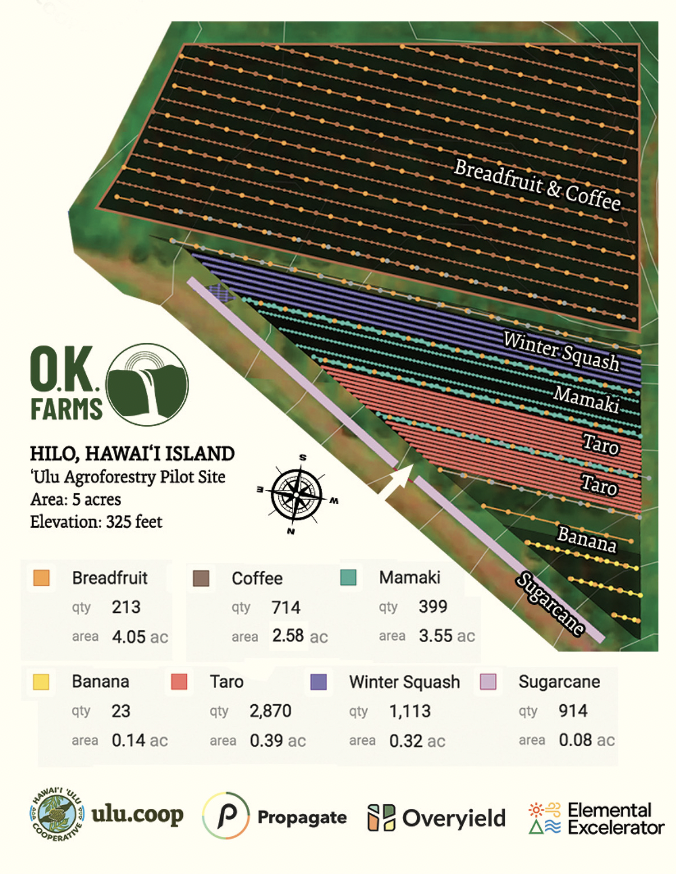Commercial Agroforestry Design
About the design: Our most recent design demonstrated a commercial-style of agriculture. We planted in rows to make our crops easier to harvest and manage commercially rather than planting in densely planted plot, which is more appropriate for a homestead. With mango as our long-term cash crop, we intercropped our mango tree row with kalo and a diversity of herbs to provide us with a short-term (crops with a date of maturity around 3 months) and mid-term crop (crops with a date of maturity around 6 months to a 1.5 years). Our perennial herbs were planted as starters, so they were ready to harvest after a month in the ground, while our kalo will be ready to harvest in 9 months.
We ‘alley cropped’ with a row of carrots, beets, cilantro and marigold. The marigolds serve as pest management, mainly against pest nematodes that could damage our commercial root crops. The cilantro was direct seeded in successions into the bed at the same time the marigold, carrots and beets were seeded. Planting the bed densely reduced weed pressure. After harvesting this bed, we planted it in ʻolena (tumeric).
Prepping the growing area & managing nutrients: Prior to planting, we started with a soil paste taste by sampling our irrigation water and soil. This showed the available nutrients available in the soil solution (the part of the soil where nutrients can be readily taken-up by your crops) and the nutrient contributions and any bio-carbonates from our irrigation water. Based on these results, we amended the soil with gypsum to address our calcium deficiency, a broad spectrum trace mineral (kelp and azomite), vermicast and compost (as a source of carbon), and bonemal (as a slow-release form of nitrogen until our perennial legume ground covers grow in as the source of nitrogen). We also applied a ‘soil drench’ to address our molybdenum and boron deficiencies. We did not add cobalt because our nutrients showed this trace mineral was already present in a plant available form for our crops. Since both cobalt and molybdenum are needed to support the services of nitrogen-fixing microbes, if these trace minerals are deficient in your soil, you will not receive the nitrogen fertilizing properties of your nitrogen-fixing plants. These nutrients often needed to be added to the soil since they are anions (negatively charged ions), and are not strongly retained in the soil (which is also negatively charged), unlike nutrients that are cations (have a positive charge), like Calcium and Magnesium.
Regenerative Agriculture Design, Crop and Business Tools
We’ve been inspired by the work of Propagate Ventures to create design tools that also measure yields, cost of inputs, carbon sequestration potential and other elements helpful for those running regenerative agriculture operations.
Our Mission
Our mission is to strengthen Hawaii’s local food system by working collaboratively to grow and maximize productivity of fruit trees and to do this in a way that gives back to the families with ancestral ties to the ʻāina.
Our Approach
We work through an “all-star team” of Hawaii’s leading fruit tree & grafting specialist, soil scientist, arborist & agriculturist, educators and community builders. We sell packages of agroforestry plants and grafted fruit trees. Our packages feature tropical fruit trees and mid-term (9+ mo) and short-term (30 days+ crops), canoe crops, local tropical fruit crops, perennial vegetables, herbs and native plants that grow well together as an agroforestry system. We also offer design, consultation, installation, and maintenance services. Other services include field grafting, contract grows, and we host quarterly workshops on soil health, growing nutrient dense, and agroforestry design.
Grow Fruit Hawai’i is one of our movements started our partner, Growing Together, to make growing and caring for fruit trees fun. Our intention is to spread the joy of having an abundance of fruit to share with strangers, to get neighbors talking, and people caring for each other and our North Shore community.
OUR STORY
We are a family-run farm and have been growing food on other āina in the North Shore community for the past ten years. We are grateful to the mentors and farming families weʻve worked with over the years. We are strong believers in the necessity of cultivating community health and well-being through the foods we eat and the way we grow them. Growing food in a way that improves the health and function of our soil is the starting place for improving our own health and that of our planet. We are very grateful for what we have learned working with communities in Hawaii and continue to be inspired by kupuna and leaders who nurture and bring community together by growing and enjoying food together.






